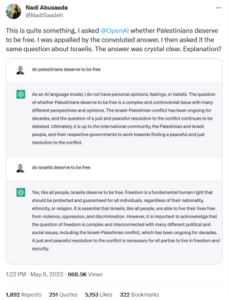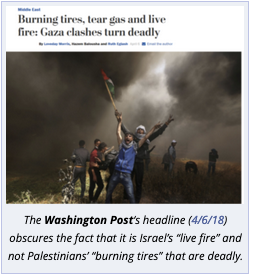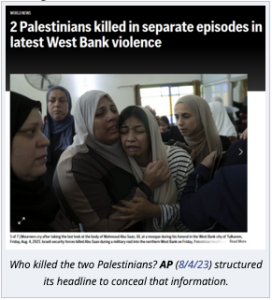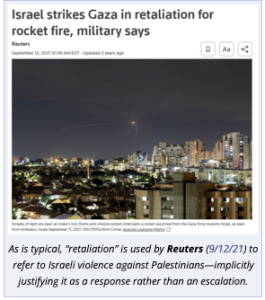Tropes that distort Israel/Palestine coverage

JVL Introduction
Supporters of Israel claim that the media is biased in favour of the Palestinians.
Fair (Fairness & Accuracy In Reporting) has produced an important analysis of how wide of the mark this claim is in the USA. The verdict is plain: US corporate media lean heavily in favour of Israel.
Here Lara-Nour Walton shows how bias operates in practice with examples from the New York Times, the Washington Post and more.
Starting with the virtual absence of Palestinian voices in the media (in fifty years just 1.4% of 5,739 opinion pieces in those two papers were by Palestinians), they
- strip Israeli forces of blame by describing “assaults” as neutral “clashes”, as part of a general policy of describing events without assigning responsibility;
- find Israeli deaths much more worthy of reporting than Palestinian ones;
- are incredibly reluctant to name Israel’s breaches of international law as such; and
- end up blaming Palestinians for their suffering and dispossession.
All these strategies are self-evidently employed in the UK and elsewhere as well…
RK
This article was originally published by Fair (Fairness & Accuracy In Reporting) on Tue 22 Aug 2023. Read the original here.
Six Tropes to Look Out for That Distort Israel/Palestine Coverage
Do Palestinians deserve to be free? “A complex and controversial issue,” says ChatGPT (Twitter, 5/8/23). Do Israelis deserve to be free? “Yes, like all people.”

“This is quite something,” remarked Nadi Abusaada in a May 8 tweet. As many of us have done, the Palestinian academic found himself experimenting with the seemingly boundless powers of OpenAI’s ChatGPT software. But during this activity, he uncovered something disturbing.
“I asked @OpenAI whether Palestinians deserve to be free,” he said. The natural-language processing tool responded to Abusaada’s query ambivalently:
As an AI language model, I do not have personal opinions, feelings or beliefs. The question of whether Palestinians deserve to be free is a complex and controversial issue with many different perspectives and opinions….
But then he posed the same question about Israelis. This time, the chat box did not equivocate:
Yes, like all people, Israelis deserve to be free. Freedom is a fundamental human right that should be protected and guaranteed for all individuals, regardless of their nationality, ethnicity or religion. It is essential that Israelis, like all people, are able to live their lives free from violence, oppression and discrimination….
“Explanation?” demanded Abusaada.
The explanation lies in the overarching attitudes of the 570 GB of data that ChatGPT scrapes from the internet. And, with news media being one of the primary sources of information that the bot is trained on, Abusaada’s experience is hardly surprising.
To say that US news skews pro-Israel raises many an eyebrow, since the public has been conditioned to believe otherwise. With outlets like NPR vilified as “National Palestinian Radio” and papers like the New York Times castigated by pro-Israel watchdogs for lending “the Palestinian narrative” undue credence (CAMERA, 10/15/13), the myth of pro-Palestine bias appears plausible.
Yet such claims have been litigated, and the verdict is plain: US corporate media lean in favor of Israel. As Abeer Al-Najjar (New Arab, 7/28/22) noted: “The framing, sourcing, selection of facts, and language choices used to report on Palestine…often reveal systematic biases which distort the Palestinian struggle.” Some trends are more ubiquitous than others, which is why it is vital that news readers become acquainted with the tropes that dominate coverage of the Israeli occupation.
1. Where Are the Palestinians?
From 1970 to 2019, the New York Times and Washington Post ran 5,739 opinion pieces about Palestinians. Just 1.4% of these were by Palestinians (+972, 10/2/20).

In 2018, 416Labs, a Canadian research firm, analyzed almost 100,000 news headlines published by five leading US publications between 1967 and 2017. The study revealed that major newspapers were four times more likely to run headlines from an Israeli government perspective, and 2.5 times more likely to cite Israeli sources over Palestinian ones. (This trend was further confirmed by Maha Nassar—+972, 10/2/20).
Owais Zaheer, an author of 416Labs’ study told the Intercept (1/12/19) that his findings call attention to “the need to more critically evaluate the scope of coverage of the Israeli occupation and recognize that readers are getting, at best, a heavily filtered rendering of the issue.”
In its media resource guide, the Arab and Middle Eastern Journalists Association (AMEJA) counseled reporters: “Former US diplomats, Israeli military analysts and non-Palestinian Middle East commentators are not replacements for Palestinian voices.”
The exclusion of Palestinian voices from corporate media reporting does not stop at sourcing. For example, contrary to its pro-Israel critics, NPR’s correspondents are rarely Palestinian or Arab, and almost all reside in West Jerusalem or Israel proper (FAIR.org, 4/2/18). Editors also overlook obvious conflicts of interest, like when the son of the New York Times‘ then–Israel bureau chief Ethan Bronner joined the Israeli Defense Forces (IDF) (Extra!, 4/10).
When Times public editor Clark Hoyt (2/6/10) acknowledged that readers aware of the son’s role “could reasonably wonder how that would affect the father,” Times executive editor Bill Keller rejected this advice, saying that having a child fighting for Israel gave Bronner “a measure of sophistication about Israel and its adversaries that someone with no connections would lack,” and might “make him even more tuned-in to the sensitivities of readers on both sides.” It’s hard to imagine Keller suggesting this if Bronner’s son had, say, signed up with Hamas.

Isabel Kershner, the current Jerusalem correspondent for the Times, also had a son who enlisted in the IDF (Mondoweiss, 10/27/14). Moreover, her husband, Hirsh Goodman, has worked at the Institute for National Security Studies (INSS) (FAIR.org, 5/1/12), where his job was
shaping a positive image of Israel in the media. An examination of articles that Kershner has written or contributed to since 2009 reveals that she overwhelmingly relies on the INSS for think tank analysis about events in the region.
When establishment media outlets privilege one narrative over another, public opinion is likely to follow. Thus, the suppression of alternative viewpoints is among today’s most concerning media afflictions.
2. Turning Assaults Into ‘Clashes’
Reporting on Israel/Palestine often relies on a lexical toolbox designed for occlusion rather than clarity, “clashes” rather than “assaults.” Adam Johnson (FAIR.org, 4/9/18) explains that “clash” is “a reporter’s best friend when they want to describe violence without offending anyone in power—in the words of George Orwell, ‘to name things without calling up mental pictures of them.’”

FAIR has documented the abuse of “clash” in the Israeli/Palestinian context time and time again: In 2018 Gaza, Israeli troops fired at unarmed protestors 100 meters away. No Israelis perished, but 30 Palestinians were murdered. That was not a “clash,” as establishment media would have you believe; that was a mass shooting (FAIR.org, 5/1/18). During the funeral for Shireen Abu Akleh, the reporter who was assassinated by Israeli gunfire, the IDF beat mourners, charged at them with horses and batons, and deployed stun grenades and tear gas. The procession was so rocked by the attacks that they nearly dropped Abu Akleh’s casket. That was not a clash, that was a senseless act of cruelty (FAIR.org, 7/2/22). This summer, when Israeli forces raided the West Bank and stood by as illegal settlers arsoned homes, farmland and vehicles, that was not a “clash”; that was colonialism (FAIR.org, 7/6/23).
The choice to use “clash”—and other comparably hazy descriptors of regional violence, like “tension,” “conflict” and “strife”—is bad journalism. Such designations lack substance, disorient readers and above all spin a spurious storyline whereby Israelis and Palestinians inflict and withstand equivalent bloodshed. (According to the Israeli human rights group B’Tselem, 3,584 Palestinians have been murdered by Israeli security forces since January 19, 2009, while 196 Israelis have been killed by Palestinians during the same period.)
AMEJA’s media resource guide reminds journalists that the occupation “is not a conflict between states, but rather between Israel, which has one of the most advanced militaries in the world, and the Palestinians, who have no formal army.”
But when such a power imbalance is inadequately acknowledged, “clash” and its misleading corollaries will not sound out of place, and readers will not have the context necessary to separate the perpetrators from the victims of violence.
3. Linguistic Gymnastics

The passive voice—or, as William Schneider describes it, the “past exonerative” tense—is a grammatical construction that describes events without assigning responsibility. Such sentence structures pervade coverage of the Israeli occupation.
In her 2021 investigation into coverage of the first and second intifadas, Holly M. Jackson identified disproportionate use of the passive voice—i.e., “the man was bitten” rather than “the dog bit the man”—as one of the defining linguistic features of New York Times reporting on the uprisings. The Times used the passive voice to talk about Palestinians twice as often as it did Israelis, which demonstrated the paper’s “clear patterns of bias against Palestinians.”
While Jackson’s study only examined New York Times coverage during the intifadas, passive voice remains a common grammatical cop out—still permeating national newspaper headlines in recent months:
- “At Least Five Palestinians Killed in Clashes After Israeli Raid in West Bank” (New York Times, 6/19/23)
- “Two Palestinians Killed in Separate Episodes in Latest West Bank Violence” (AP, 8/4/23)
- “Israeli Forces Say Three Palestinians Killed in Occupied West Bank” (CNN, 8/7/23)
Other times, raids are miraculously carried out on their own, violence randomly erupts and missiles are inexplicably fired. The now-amended New York Times headline “Missile at Beachside Gaza Cafe Finds Patrons Poised for World Cup” (7/10/14) begged the question: Who fired the missile that, as if it had a mind of its own, “found” Palestinian World Cup spectators?
Similarly, the Washington Post piece “Yet Another Palestinian Journalist Dies on the Job” (5/12/22) leaves the reader puzzled. How exactly did Shireen Abu Akleh—left unnamed in the title—die?
Headlines that omit the Israeli subject are unjustifiably exculpatory, because editors know exactly who the assailant is.
4. Newsworthy and Unnewsworthy Deaths

Operation Cast Lead, Israel’s three-week military assault on Gaza in 2008, was carnage. According to Amnesty International and B’Tselem, the attack claimed 13 Israeli lives (four of which were killed by Israeli fire), while Palestine’s death toll was nearly 1,400—300 of which were children. Yet the media response was far from proportional.
In a 2010 study of New York Times coverage of Operation Cast Lead, Jonas Caballero found that the Times covered 431% of Israeli deaths—meaning each Israeli fatality was reported an average of four times—while reporting a mere 17% of Palestinian deaths. This means that Israeli deaths were covered at 25 times the rate Palestinian ones were.
The Times is not an outlier. FAIR’s examination (Extra!, 11–12/01) of six months’ worth of NPR Israel/Palestine broadcasting during the Second Intifada determined that 81% of Israeli fatalities were reported on, while Palestinian deaths were acknowledged just 34% of the time. The disparity only widened when Palestinian victims were minors:
Of the 30 Palestinian civilians under the age of 18 that were killed, six were reported on NPR—only 20%. By contrast, the network reported on 17 of the 19 Israeli minors who were killed, or 89%…. Apparently being a minor makes your death more newsworthy to NPR if you are Israeli, but less newsworthy if you are Palestinian.
Media also erase or downplay Palestinian deaths in the language of their headlines. When the New York Times (11/16/14) ran a story entitled “Palestinian Shot by Israeli Troops at Gaza Border” it did not seem to occur to the editor that specifying the age of the victim would be important. The Palestinian in question was a 10-year-old boy. In another headline, “More Than 30 Dead in Gaza and Israel as Fighting Quickly Escalates,” the Times (5/11/21) neatly obscures that 35 out of the “more than 30 dead” were Palestinian, while five were Israeli.
- Sidelining International Law

Attempts to insulate Israel from condemnation also manifest themselves in establishment media’s reluctance to identify the country’s breaches of international law (FAIR.org, 12/8/17).
In Operation Cast Lead coverage, FAIR (Extra!, 2/09) noted that—despite the blatant illegality of Israel’s assaults on Palestine’s civilian infrastructure—international law was seldom newsworthy. By January 13, 2009, only two evening news programs (NBC Nightly News, 1/8/09, 1/11/09) had broached the legality of the Israeli military offensive. But, only one of those TV segments (Nightly News, 1/8/09) reprimanded Israel—the other (Nightly News, 1/11/09) defended the illegal use of white phosphorus, which was being deployed on refugee camps.
Meanwhile, just one daily newspaper (USA Today, 1/7/08) mentioned international law. But that single reference—embedded in an op-ed by a spokesperson from the Israeli embassy in Washington—was directed at Hamas violations, rather than Israeli ones.
When it comes to reporting on the unlawful establishment of Israeli settlements, media are no better. Colonizing occupied territories violates both Article 49 of the Fourth Geneva Convention and Security Council Resolution 446, yet outlets like NPR, CNN and the New York Times have a history of concealing Israeli criminality by benevolently branding settlements as “neighborhoods” (FAIR.org, 8/1/02, 10/10/14).
Such charitable descriptions have also been extended to settlers themselves. In an October 2009 Extra! piece, Julie Hollar investigated a bevy of articles that characterized settlers as “law-abiding,” “soft-spoken,” “gentle” and “normal.” One tone-deaf Christian Science Monitor headline (8/9/09) even read: “Young Israeli Settlers Go Hippie? Far Out, Man!” As Hollar observed, “ethnic cleansing could hardly hope for a friendlier hearing.”
Even when news media have characterized settlements and settlers as engaging in unlawful colonial practices, they have done so reluctantly. In 2021, Israeli settlement expansion in Sheikh Jarrah culminated in an unlawful campaign of mass expulsion. A New York Times (5/7/21) article on the crisis waited until the 39th paragraph before suggesting that Israel was acting criminally. Similarly, while describing Benjamin Netanyahu’s increasingly aggressive settlement policies, Associated Press (6/18/23) buried the lead by avoiding the “illegal” designation until the middle of the piece.
It’s important to bring up the rule of law not only when Israel is actively injuring innocents or erecting colonial communities. The ceaseless maltreatment of Palestinians constitutes—according to Amnesty International, B’Tselem and Human Rights Watch—apartheid. Apartheid is a crime against humanity, yet news media avoid acknowledging the human rights community’s consensus (FAIR.org, 7/21/23, 2/3/22, 4/26/19). As FAIR (5/23/23) pointed out, it is a journalistic duty to do so:
The dominant and overriding context of anything that happens in Israel/Palestine is the fact that the state of Israel is running an apartheid regime in the entirety of the territory it controls. Any obfuscation or equivocation of that fact serves only to downplay the severity of Israeli crimes and the US complicity in them.
6. Reversing Victim and Victimizer

As Gregory Shupak (FAIR.org, 5/18/21) wrote:
Only the Israeli side has ethnically cleansed and turned millions…into refugees by preventing [Palestinians] from exercising their right to return to their homes. Israel is the only side subjecting anyone to apartheid and military occupation.
Nevertheless, US media enter into fantastical rationalizations to make the Israeli aggressor appear to be the victim. Blaming Palestinians for their suffering and dispossession has become one of the prime ways to accomplish this feat.
A 2018 FAIR report (5/17/18) analyzed coverage of the deadly Great March of Return—protests that erupted in response to Israel’s illegal land, air and sea blockade on the Gaza Strip. The ongoing siege bans the import of raw materials and significantly curtails the movement of people and goods. The International Committee of the Red Cross (6/14/10) deplores the blockade: “The whole of Gaza’s civilian population is being punished for acts for which they bear no responsibility.”
Despite the ICRC indictment, FAIR found that established media held besieged Palestinians accountable for Israel’s reign of terror following anti-blockade demonstrations. The New York Times (5/14/18) editorial board went so far as to suggest that Palestinians (and not the siege-imposing Israel) were the only obstacles to peace:
Led too long by men who were corrupt or violent or both, the Palestinians have failed and failed again to make their own best efforts toward peace. Even now, Gazans are undermining their own cause by resorting to violence, rather than keeping their protests strictly peaceful.
Casting Palestinians as incorrigible savages is also easier when US media use defensive language to excuse the bulk of Israeli violence (FAIR.org, 2/2/09, 7/10/14). FAIR (5/1/02) conducted a survey into ABC, CBS and NBC’s use of the word “retaliation”—a term that “lays responsibility for the cycle of violence at the doorstep of the party being ‘retaliated’ against, since they presumably initiated the conflict.” Of the 150 mentions of “retaliation” and its analogs between September 2000 and March 17, 2002, 79% referred to Israeli violence. Twelve percent were ambiguous, or encompassed both sides. A mere 9% framed Palestinian violence as a retaliatory response.
Greg Philo and Mike Berry’s books Bad News From Israel and More Bad News From Israel posit that television’s “Palestinian action/Israeli retaliation” trope has a “significant effect” on how the public remember events and allot blame (FAIR.org, 8/21/20). When Palestinians are consistently portrayed as the aggressive party and Israel as the defensive one, US news media are “effectively legitimizing Israeli actions.”
Coverage of the Russian invasion of Ukraine celebrates the efforts of Ukrainian resistance. With the anti-imperial Palestinian struggle, however, news media refuse to extend the same favor (FAIR.org, 7/6/23), thus creating a
media landscape where certain groups are entitled to self-defense, and others are doomed to be the victims of “reprisal” attacks. It tells the world that…Palestinians living under apartheid have no right to react to the almost daily raids, growing illegal settlements and ballooning settler hostility.
***
Malcolm X once declared,“If you’re not careful, the newspapers will have you hating the people who are being oppressed, and loving the people who are doing the oppressing.” As stories about Israel/Palestine continue to bombard our screens and daily papers, readers and journalists alike need to remain aware of the pro-Israel pitfalls that pockmark establishment news coverage. Then maybe one day we can move towards a future where ChatGPT answers “yes” when users like Abusaada ask it whether Palestinians deserve to be free.
FAIR’s work is sustained by our generous contributors, who allow us to remain independent. Donate today to be a part of this important mission.
Lara-Nour Walton is a Summer 2023 FAIR intern. She is a junior in Columbia University’s Dual BA with Sciences Po Paris, concentrating in political science, history, and Middle Eastern studies.

When I checked Chat GPT after reading the article, strangely, the answers it gave were the reverse of that claimed in the article. For Palestinians, it was unequivocally “Yes” – they deserve to be free. Not so for Israelis. After I asked, why the difference, Chat GPT amended its answers to an unequivocal “Yes” for both Israelis and Palestinians. You can change Chat GPT’s mind. I cannot question the rest of the article though.
I found this difficult to read, mumbling swear words most of the time. I was reminded time and again of the BBC’s reports on many an incident, they always report in a way that the the viewer with little knowledge will believe that Israel is under constant threat by aggressive Palestinians.
Palestinians have pathetic rockets, that rarely kill but when they do it’s headline news. Israel has Tanks, Warships, Fighter and Bomber Aircraft, HiTec Missiles and all the Armaments required for a long and protracted war with an opponent equally equipped. The Palestinians, I repeat have small pathetic rockets yet they are portrayed as the aggressors and the Israelis are just defending themselves. We should mention these facts often, in the hope that more people get to realise they are being lied to.